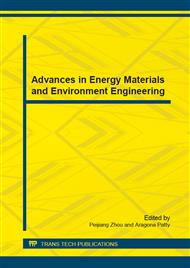[1]
Chaoying Peng, Guohong Zhu and Guo Yin. Environmental Protection26(2000), pp.24-26. (In Chinese).
Google Scholar
[2]
Rixing Lan. Jilin Agriculture(2012), pp.63-64. (In Chinese).
Google Scholar
[3]
Xingsheng Lin, Zhanxi Lin, Dongmei Lin, Hui Lin, Hailing Luo, Yingping Hu, Chunmei Lin and Chaozhi Zhu. Acta Ecologica sinica15(2014). (In Chinese).
DOI: 10.5846/stxb201212071760
Google Scholar
[4]
Peng Ma, Changxiao Li, Ming Lei, Yujing Yang ang Jun Ma. Acta Ecologica Sinica34(2014), pp.1010-1020. (In Chinese).
Google Scholar
[5]
Junhua Ao, Haihua Deng, Qiwei Li, Zhenrui Huang and Yong Jiang. Guangdong Agricultural Sciences(2007), pp.177-180. (In Chinese).
Google Scholar
[6]
Gang Xu. Effect of Sewage Irrigation with Molasses Alcohol Wastewater on Soil Quality. Guangxi University(2007). (In Chinese).
Google Scholar
[7]
Gemtos TA & Chouliaras N & Marakis S. Vinasse Rate, Time of Application and Compaction Effect on Soil Properties and Durum Wheat Crop. Joumal of Agrieultural Engineering Researeh73(1999), p. 283一296.
DOI: 10.1006/jaer.1999.0419
Google Scholar
[8]
Litao Yang, Fenglian Mo, Qiuzhen Zhu, Nan Li, Zongxi Ou ang Yangrui Li. Journal of Southern Agri-culture43(2012), pp.18-21. (In Chinese).
Google Scholar
[9]
Yunchuan Mo. Influence of Vinasse on Sugarcane and Soil in Sugarcane Field. Guangxi University(2007). (In Chinese).
Google Scholar
[10]
Jiao R Z. Yang C D. The changes of the soil Microorganism in rhizosphere and outside in different developing stage of the Chinese fir plantation. Scientia Silvace Sinicae35(1999), pp.53-59.
Google Scholar
[11]
Shangdong Yang, Jun Wu, Jiucheng Zhao, Hongwei Tan and Yangrui Li. Southwest China Journal of Agricultural Sciences25(2012), pp.2147-2152. (In Chinese).
Google Scholar
[12]
Zepu Jiang, Guangpo Wei, Qing Liao, Tianming Su, Yancheng Meng, Haiying Zhang, Changyan Lu and Yangrui Li. Effect of longterm vinasse application on physical properties of soil in sugarcane fields. Guangxi Agricultural Sciences41(2010).
Google Scholar
[13]
Haitao Tian, Xisheng Hu, Shaofeng Zhang, Jian Xie, Dong Zhang and Jinsong An. Marine Environmental Science33(2014), pp.187-191. (In Chinese).
Google Scholar
[14]
Sifeng Zhang and Hanmeng Liu. Acta Ecologica Sinica30 (2010), pp.2735-2744. (In Chinese).
Google Scholar
[15]
Yanlan Mo. Microbial Diversity in Sugarcane Field treated with Different rates of Vinasse. Guangxi University(2008). (In Chinese).
Google Scholar
[16]
Jia Zhao, Haiying Zhang and Jie Wang. Jilin Agri-cultural(2010), pp.49-50. (In Chinese).
Google Scholar
[17]
Yiding Wang, Mingze Wei, Liming Bi, Yangrui Li, Weihao Wang and Yanping Ye. Southwest China Journal of Agricultural Science19(2006), pp.482-485. (In Chinese).
Google Scholar


